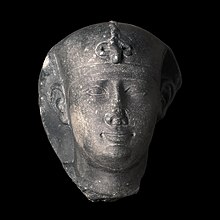Nectanebo II
| Nectanebo II | |
|---|---|
| Nakhthorheb | |

Head of Nectanebo II, Museum of Fine Arts of Lyon
|
|
| Pharaoh | |
| Reign | 360–342 BC(Thirtieth Dynasty) |
| Predecessor | Teos |
| Successor | Artaxerxes III |
| Father | Tjahapimu |
Nectanebo II (Manetho's transcription of Egyptian Nḫht-Ḥr-Ḥbyt, "Strong is Horus of Hebit"), ruled in 360—342 BC) was the third and last pharaoh of the Thirtieth Dynasty of Egypt as well as the last native ruler of ancient Egypt.
Under Nectanebo II, Egypt prospered. During his reign, the Egyptian artists delivered a specific style that left a distinctive mark on the reliefs of the Ptolemaic Kingdom. Like his indirect predecessor Nectanebo I, Nectanebo II showed enthusiasm for many of the cults of the gods within ancient Egyptian religion, and more than a hundred Egyptian sites bear evidence of his attentions. Nectanebo II, however, undertook more constructions and restorations than Nectanebo I, commencing in particular the enormous Egyptian temple of Isis (the Iseum).
For several years, Nectanebo II was successful in keeping Egypt safe from the Achaemenid Empire. However, betrayed by his former servant, Mentor of Rhodes, Nectanebo II was ultimately defeated by the combined Persian and Greek forces in the Battle of Pelusium (343 BC). The Persians occupied Memphis and then seized the rest of Egypt, incorporating the country into the Achaemenid Empire. Nectanebo fled south and preserved his power for some time; his subsequent fate is unknown.
Except for the small-scale greywacke statue in the Metropolitan Museum of Art, which shows Nectanebo II standing before the image of Horus, no other annotated portraits of Nectanebo II are known. In the greywacke statue, Nectanebo II is shown in a nemes and uraeus. His bent arm with the sword stands for the hieroglyph nakht, the falcon represents Horus, while the hieroglyph in Nectanebo's right hand stands for heb. Other portraits attributed to Nectanebo II (all featuring the khepresh) include a quartzite head in the museum of the University of Pennsylvania Museum of Archaeology and Anthropology, a basalt head in Alexandria, a granite head acquired by the Museum of Fine Arts, Boston and a damaged quartzite head.
...
Wikipedia
